
Standard Uranium Confirms Uranium Mineralization in Multiple Drill Holes at Atlantic Project; Provides Analytical Highlights from Winter Drill Program

Standard Uranium Ltd. (TSX-V: STND) (OTCQB: STTDF) (Frankfurt: FWB:9SU) is pleased to announce a summary of analytical results from the inaugural winter 2024 drill program at its 3,061-hectare Atlantic Project highlighting uranium mineralization in multiple drill holes. Atlantic is situated in the prolific eastern Athabasca Basin, northern Saskatchewan (Figure 1).
The Project is currently under option to ATCO Mining Inc. an arms-length company listed on the Canadian Securities Exchange (CSE: ATCM). Pursuant to the Option, the Optionee can earn a 75% interest in Atlantic over three years. The Optionee-funded winter 2024 drill program contributes to satisfying the first year of minimum exploration expenditures required by the Option.
Highlights:
- Uranium Mineralization Confirmed: Analytical results from the winter 2024 drill program at the Project confirmed highly anomalous uranium in drill holes ATL-24-002, ATL-24-004A, and ATL-24-005A, coinciding with prospective structural zones and favorable alteration including dravite-rich clays.
- Sandstone & Basement-Hosted Uranium: Multiple zones of elevated uranium linked to the sub-Athabasca unconformity and basement structural zones were intersected, indicating a uranium-fertile system.
- Uranium Pathfinders: Several key uranium pathfinder elements are present in anomalous quantities in multiple drill holes, providing vectoring information for future programs. Intersections of dravitic-clay associated with structural zones has been confirmed in drill holes ATL-24-002, ATL-24-004A, and ATL-24-005A.
- Verified Targets: Massive structural disruption confirmed in the sandstone column and multiple wide (>10 metres) brittle-reactivated graphitic shear zones confirm the main interpreted electromagnetic (“EM”) corridor on the western claim block which was not reached by previous operators. The inaugural program results have confirmed the Company’s exploration thesis on the Project, highlighting a uranium-fertile system with several kilometres of still untested strike length across the Project.
- Follow Up Targets & Next Steps: Atlantic holds significant upside for discovery along the untested portions of the E-W conductor system. Supplementary geophysical surveys over the central claim blocks are currently being planned and will provide further target areas for phase II and III drilling, along with the additional untested gravity low anomalies on the western block identified in 2022.
“Confirming uranium mineralization and dravite alteration in multiple holes from our inaugural drill program at Atlantic is a fantastic first result. In addition, highly anomalous pathfinder elements coupled with the presence of a significant structural framework on the property provides the ideal conditions for high-grade unconformity-related uranium mineralization to follow up on,” said Sean Hillacre, Standard Uranium’s VP of Exploration. “The scale and intensity of deformation in the basement rocks paired with strong alteration in the sandstone is highly prospective and we are just beginning to reveal the compelling uranium story along this 18 km-long trend next door to one of the highest-grade uranium deposits in the world.”
The Atlantic Project covers 6.5 km of an 18 km long, east-west trending conductive exploration trend which hosts numerous uranium occurrences. The Company completed a high-resolution ground gravity survey on the western claim block in 2022, revealing multiple subsurface density anomalies, potentially representing significant hydrothermal alteration zones in the sandstone rooted to basement conductors.
The Atlantic project boasts all the key characteristics to host a high-grade unconformity-related uranium deposit, and the results of the inaugural drill program on the project have strengthened the validity of the exploration thesis on the Project. Follow up targets are being planned as geological data from the winter 2024 program continues to be processed and interpreted. Core samples from the program have been submitted to Saskatchewan Research Council Geoanalytical Laboratory in Saskatoon, for geochemical assay and results will be reported once received and examined by the technical team in accordance with the Company’s internal quality control processes.
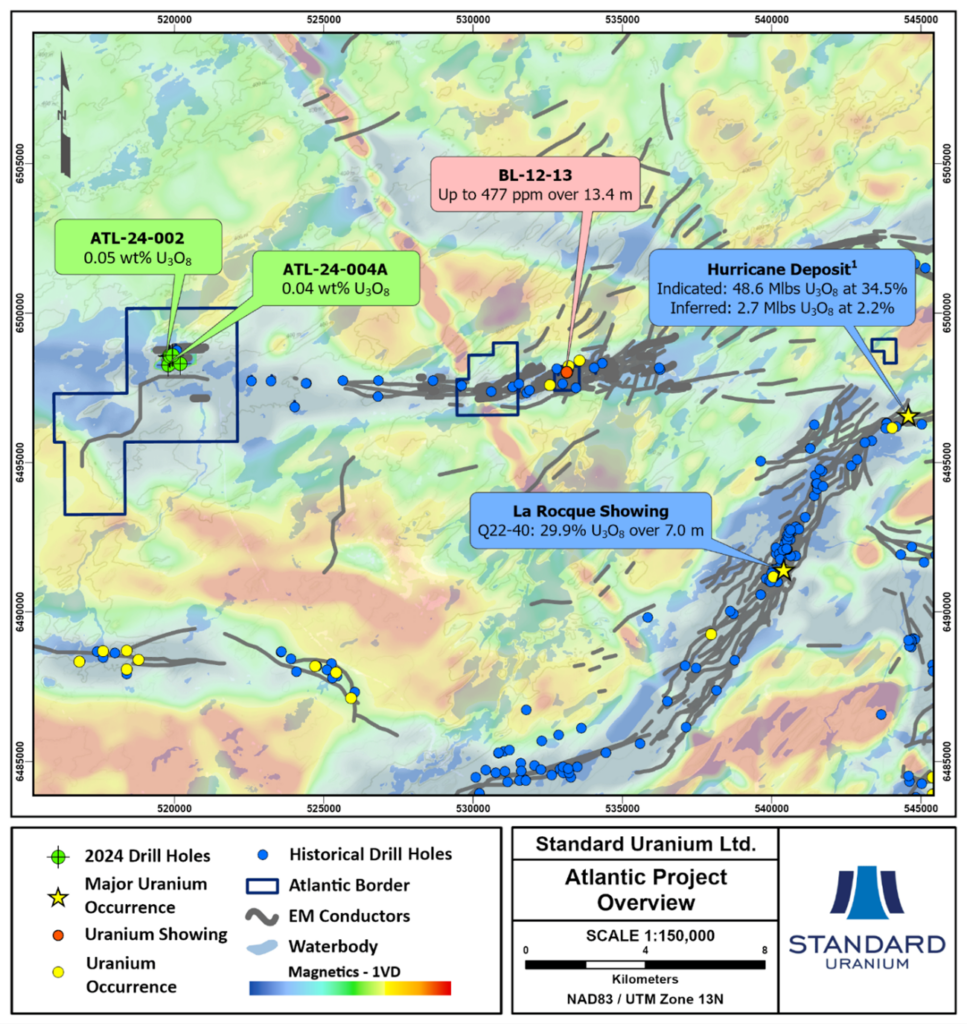
Figure 1. Regional summary map of the Atlantic Project highlighting uranium occurrences, historical and 2024 drill holes, geophysical anomalies, and EM conductors.
Winter 2024 Drill Program Analytical Highlights:
The winter 2024 drill program comprised 3,316 metres of diamond drilling across 5 drill holes (Table 1). Inaugural drilling intersected the key characteristics of a uranium-bearing mineralized system in previously untested “Target Area A” (Figure 2), confirming the presence of a significant graphitic fault system in the basement rock linked to uranium mineralization and prospective hydrothermal alteration at the unconformity and in the basement rock. Uranium analytical highlights are summarized in Table 2 and anomalous uranium pathfinder elements highlights are summarized in Table 3.
The highly prospective drilling results are visually summarized in schematic cross-sections highlighting dravite alteration, structure, and uranium results intersected during the inaugural drill program in Figures 3 and 4.
The drill program was designed to follow up on highly anomalous uranium results returned from drill hole BL-16-32, in addition to testing the newly outlined gravity lows defined by the 2022 ground survey. On the western Atlantic claim block, drilling by Denison Mines in 2016 (Hole BL-16-32) identified 342 ppm uranium over 0.5 metres at the base of the sandstone, just north of Target Area A. Winter drilling was focused in Target Area A which is defined by a 1,400-metre x 850-metre density-low anomaly coinciding with stacked EM conductors and an interpreted regional fault. Figure 2 highlights winter 2024 drilling focused on testing the 3D density anomaly target at the unconformity linked to basement EM conductors and interpreted fault trends.
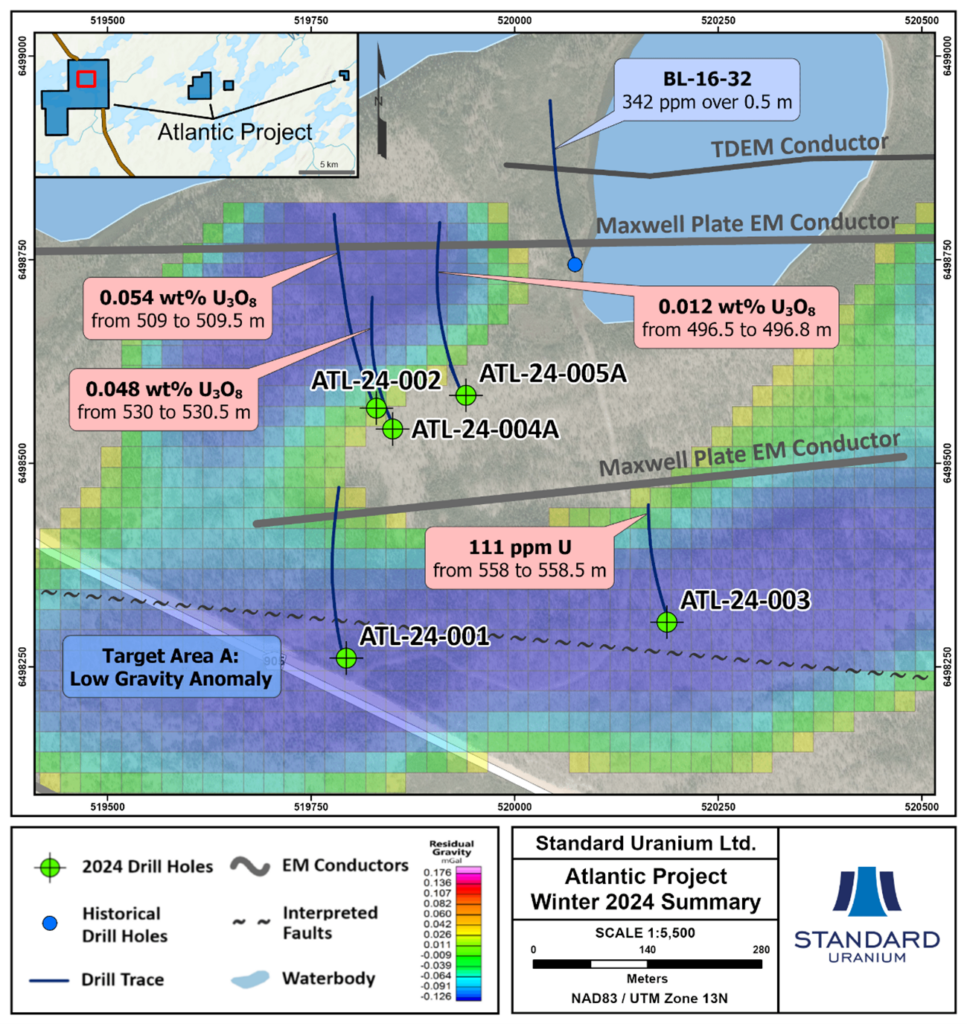
Figure 2. Map of the western Atlantic claim block, highlighting winter 2024 drill holes and historical drill hole BL-16-32. The geophysical “Target Area A” is defined by a significant residual gravity-low anomaly coinciding with EM conductors dipping to the south.
Table 1. Atlantic winter 2024 drill hole collar summary. Easting and Northing coordinates are reported in UTM Zone 13N, NAD83 datum; EOH = end of hole; m.a.s.l. = metres above sea level.
| DDH | Easting | Northing | Elevation (m.a.s.l.) | Azimuth (°) | Dip (°) | EOH (m) |
| ATL-24-001 | 519790 | 6498261 | 412 | 344.80 | -69 | 599 |
| ATL-24-002 | 519828 | 6498570 | 394 | 336.90 | -67 | 641 |
| ATL-24-003 | 520190 | 6498305 | 396 | 338.20 | -74 | 588 |
| ATL-24-004* | 519851 | 6498546 | 388 | 336.20 | -74 | 60 |
| ATL-24-004A | 519851 | 6498546 | 388 | 336.20 | -74 | 657 |
| ATL-24-005* | 519936 | 6498584 | 398 | 335.90 | -69 | 111 |
| ATL-24-005A | 519936 | 6498584 | 398 | 336.40 | -69 | 660 |
* Restarted due to difficult ground conditions.
Table 2. Atlantic winter 2024 drill hole uranium assay summary. Uranium parts-per-million (“ppm”) results are reported in partial digestion, with corresponding U3O8 weight percent (“wt%”) results where applicable.
| DDH | From (m) | To (m) | Width (m) | Lithology | Uranium (partial, ppm) | U3O8(wt%) |
| ATL-24-001 | 590.0 | 590.1 | 0.1 | Basement | 24.6 | – |
| ATL-24-002 | 508.5 | 509.0 | 0.5 | Sandstone | 93.1 | 0.015 |
| 509.0 | 509.5 | 0.5 | 448 | 0.054 | ||
| 509.5 | 510.0 | 0.5 | 52.8 | 0.008 | ||
| ATL-24-003 | 558.0 | 558.5 | 0.5 | Basement | 111 | – |
| ATL-24-004A | 491.0 | 491.5 | 0.5 | Sandstone | 16.6 | – |
| 530.0 | 530.5 | 0.5 | Basement | 274 | 0.048 | |
| 544.0 | 544.5 | 0.5 | 88.2 | 0.014 | ||
| 544.5 | 545.0 | 0.5 | 109 | 0.015 | ||
| 549.0 | 549.5 | 0.5 | 128 | – | ||
| 549.5 | 550.0 | 0.5 | 120 | 0.018 | ||
| ATL-24-005A | 492.5 | 493.0 | 0.5 | Sandstone | 41.2 | 0.008 |
| 493.0 | 493.5 | 0.5 | 44.7 | 0.007 | ||
| 494.5 | 495.0 | 0.5 | 64.2 | 0.01 | ||
| 495.0 | 495.5 | 0.5 | 17.4 | 0.002 | ||
| 495.5 | 496.0 | 0.5 | 13 | 0.002 | ||
| 496.0 | 496.5 | 0.5 | 44.4 | 0.006 | ||
| 496.5 | 496.8 | 0.3 | 82.7 | 0.012 |
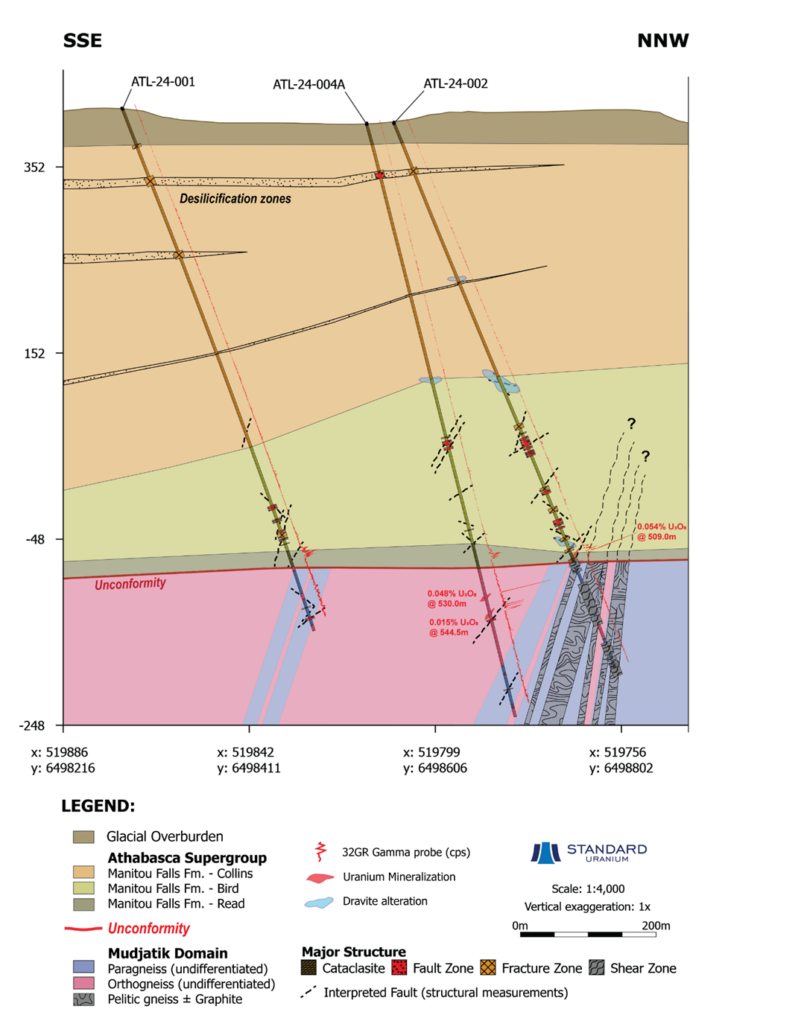
Figure 3. Schematic cross-section of drill holes ATL-24-001, ATL-24-002, and ATL-24-004A, facing west. Drill hole intersections of uranium, dravite alteration, and structure are highlighted.
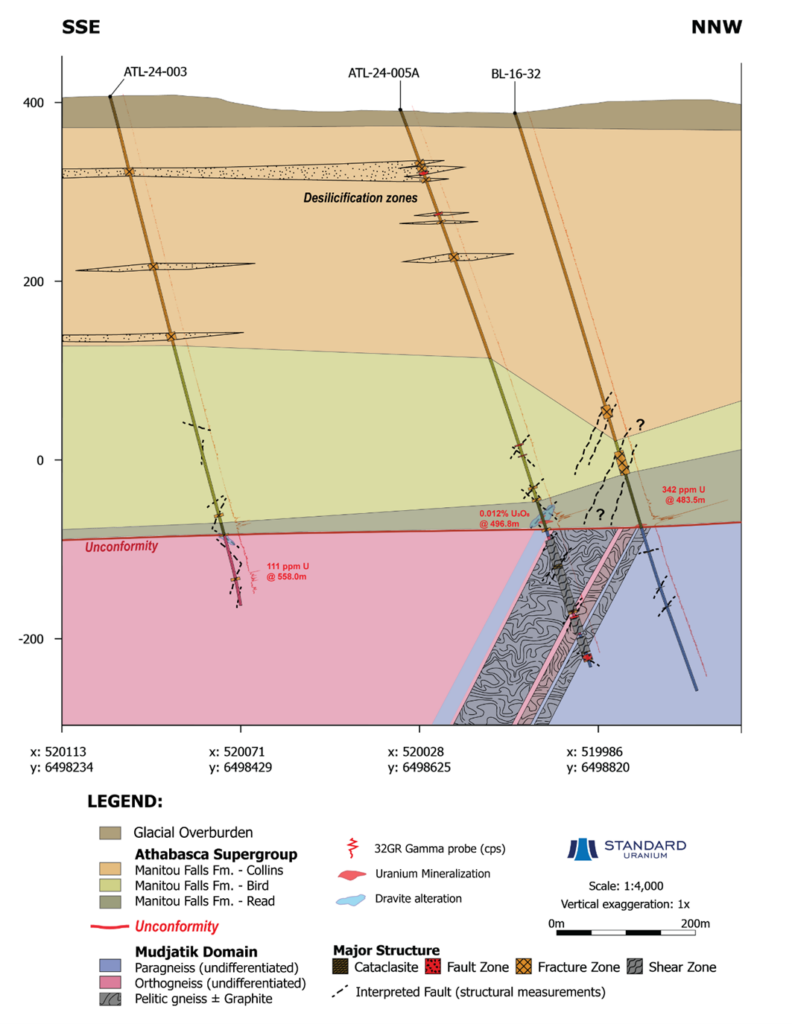
Figure 4. Schematic cross-section of drill holes ATL-24-003, ATL-24-005A, and historical drill hole BL-16-32 (Denison Mines), facing west. Drill hole intersections of uranium, dravite alteration, and structure are highlighted.
Table 3. Atlantic winter 2024 drill hole pathfinder geochemistry summary. Results are reported in parts-per-million partial digestion.
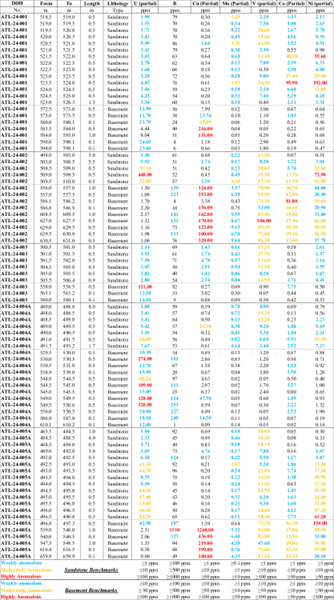
Samples collected for analysis were sent to SRC Geoanalytical Laboratories in Saskatoon, Saskatchewan for preparation, processing, and ICP-MS multi-element analysis using total and partial digestion, gold by fire assay, and boron by fusion. Sandstone samples were tested using the ICP-MS1 uranium multi-element exploration package plus boron. Basement samples were tested with ICP-MS2 uranium multi-element exploration package plus boron. All sandstone samples, and basement samples marked as radioactive upon arrival to the lab were also analyzed using the U3O8 assay (reported in wt %). Basement rock split interval samples range from 0.1 to 0.5 m and sandstone composite samples are comprised of multiple equal sized full core “pucks” spaced over the sample interval. SRC is an ISO/IEC 17025/2005 and Standards Council of Canada certified analytical laboratory. Blanks, standard reference materials, and repeats were inserted into the sample stream at regular intervals in accordance with Standard Uranium’s quality assurance/quality control (QA/QC) protocols. All samples passed internal QA/QC protocols and the results presented in this release are deemed complete, reliable, and repeatable.
Samples containing clay alteration were sent to Rekasa Rocks Inc. in Saskatoon, Saskatchewan to be analyzed by Short Wavelength Infrared Reflectance via a Portable Infrared Mineral Analyzer to verify clay species.
1 The Company considers radioactivity readings greater than 300 counts per second (cps) to be “anomalous”.
2 The Company considers uranium mineralization with concentrations greater than 1.0 wt% U3O8 to be “high-grade”.
3 Natural gamma radiation in diamond drill core reported in this news release was measured in counts per second (cps) using a handheld RS-125 super-spectrometer and verified using a down-hole Mount Sopris 32GR slim gamma probe. The 32GR gamma probe has been calibrated to optimize the probe for uranium exploration logging and estimating weight percent U3O8 content. Readers are cautioned that scintillometer and gamma probe readings are not uniformly or directly related to uranium grades of the rock sample measured and should be treated only as a preliminary indication of the presence of radioactive minerals. All drill hole intersections are measured down-hole. Core interval measurements and true thicknesses are yet to be determined.
The scientific and technical information contained in this news release has been reviewed, verified, and approved by Sean Hillacre, P.Geo., President and VP Exploration of the Company and a “qualified person” as defined in NI 43-101.
About Standard Uranium
We find the fuel to power a clean energy future
Standard Uranium is a uranium exploration company and emerging project generator poised for discovery in the world’s richest uranium district. The Company holds interest in over 209,867 acres (84,930 hectares) in the world-class Athabasca Basin in Saskatchewan, Canada. Since its establishment, Standard Uranium has focused on the identification, acquisition, and exploration of Athabasca-style uranium targets with a view to discovery and future development.
Standard Uranium has successfully completed four joint venture earn in partnerships on their Sun Dog, Canary, Atlantic and Ascent projects totaling over $31M in work commitments over the next three years from 2024-2027.
Standard Uranium’s Davidson River Project, in the southwest part of the Athabasca Basin, Saskatchewan, comprises ten mineral claims over 30,737 hectares. Davidson River is highly prospective for basement-hosted uranium deposits due to its location along trend from recent high-grade uranium discoveries. However, owing to the large project size with multiple targets, it remains broadly under-tested by drilling. Recent intersections of wide, structurally deformed and strongly altered shear zones provide significant confidence in the exploration model and future success is expected.
Standard Uranium’s eight eastern Athabasca projects comprise thirty mineral claims over 32,838 hectares. The eastern basin projects are highly prospective for unconformity related and/or basement hosted uranium deposits based on historical uranium occurrences, recently identified geophysical anomalies, and location along trend from several high-grade uranium discoveries.
Standard Uranium’s Sun Dog project, in the northwest part of the Athabasca Basin, Saskatchewan, is comprised of nine mineral claims over 19,603 hectares. The Sun Dog project is highly prospective for basement and unconformity hosted uranium deposits yet remains largely untested by sufficient drilling despite its location proximal to uranium discoveries in the area.
MORE or "UNCATEGORIZED"
Kuya Silver Confirms High-Grade Silver-Gold Vein Mineralization at Umm-Hadid with Initial Drill Results up to 1483.9 g/t AgEq over 2 Metres
Kuya Silver Corporation (CSE: KUYA) (OTCQB: KUYAF) (FSE: 6MR1) is... READ MORE
First Phosphate Closes Final Tranche of Oversubscribed Private Placement
First Phosphate Corp. (CSE: PHOS) (OTCQX: FRSPF) (FSE: KD0) is... READ MORE
GFG Receives Final Payment from the Sale of its Rattlesnake Hills Gold Project
GFG Resources Inc. (TSX-V: GFG) (OTCQB: GFGSF) announces that i... READ MORE
Goliath Receives $1,730,882 Through Warrant Exercises, Inclusive Of Crescat Capital A Longtime Strategic And Cornerstone Shareholder
Goliath Resources Limited (TSX-V: GOT) (OTCQB: GOTRF) (FSE: B4IF)... READ MORE
Robex Pours First Gold at Kiniéro on Schedule and Budget
Highlights: Gold bar weighing 2.64 kilograms (85 oz) poured in th... READ MORE












